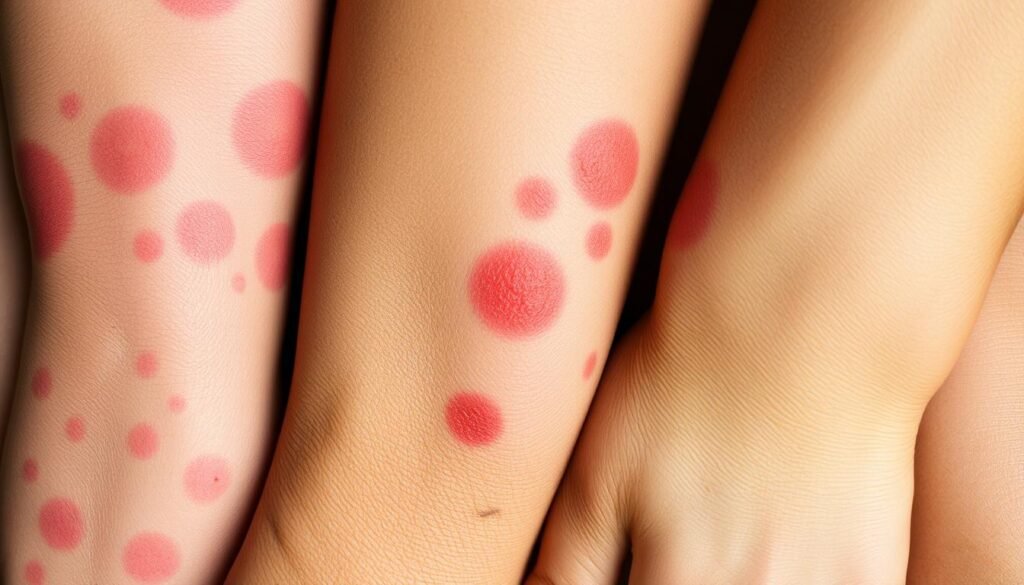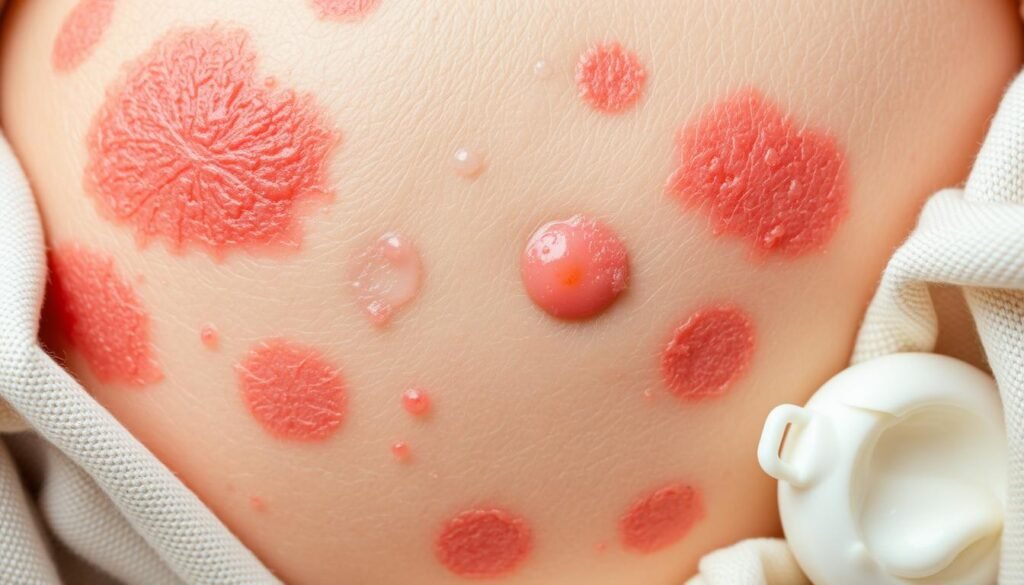Over 18 million adults in the U.S. have atopic dermatitis, known as eczema. This condition usually starts before age 5. It can affect people into their teenage years and adulthood. Knowing the symptoms is key because they can greatly affect daily life.
Atopic dermatitis means the immune system is not working right. This causes itchy skin, dry patches, and red rashes. The symptoms can show up in different ways, so it’s crucial to know them. Adults might see eczema flare-ups in places where there is a lot of rubbing or sweating. Changes in lifestyle can help avoid these triggers. The symptoms can also change and look different in people, especially in different skin tones.
For more on this condition, see the detailed overview of atopic dermatitis.
Key Takeaways
- Atopic dermatitis often begins in early childhood and can continue throughout life.
- Understanding symptoms like itchy skin and dry patches is vital for early intervention.
- Identifying triggers can help manage eczema flare-ups effectively.
- Symptoms can vary across age groups and racial demographics.
- Proper skin care routines can prevent the recurrence of symptoms.
Understanding Atopic Dermatitis
Atopic dermatitis is a long-lasting skin issue, falling under the larger eczema category. It often starts within the first six months of a child’s life. Many kids worldwide suffer from it. People with this condition may have very itchy, dry skin, along with bumps or rough patches.
One key cause behind atopic dermatitis is genetics, especially if asthma or hay fever runs in the family. In the U.S., up to 20% of kids get affected. Moreover, it’s becoming more common among certain groups, like children of black Caribbean descent in London.
This skin issue isn’t spread from person to person. But genetics and environmental factors like smoke play a big role. Those with certain genetic changes may be more at risk.
Managing atopic dermatitis well can greatly improve life quality. Mount Sinai’s Center for Excellence in Eczema is leading the way with new treatments. They offer personalized care plans. This includes figuring out allergens, using light therapy, and special medications.
Effective skin care, like regular moisturizing and avoiding triggers, is key. Exciting research into probiotics and new treatments is offering hope to many.
Looking for more info on eczema and ways to handle it? The National Eczema Association is a great place to start. They offer valuable information for both patients and doctors.
What Are the Key Atopic Dermatitis Symptoms?
Atopic dermatitis comes with different symptoms for each person. Some often-seen symptoms of atopic dermatitis are:
- Itchy Skin: This may be the most upsetting symptom, causing a lot of scratching.
- Dry Patches: Skin areas become dry, leading to flaking or cracks.
- Red Rashes: Rashes change based on skin color, showing up as red patches.
- Thickened Skin: Scratching a lot over time can make the skin thick.
- Small Bumps: Small raised bumps may form, leaking fluid if scratched.
Knowing these symptoms is crucial as they can cause big problems if ignored. Atopic dermatitis affects about 17% of people. Since the 1970s, the number of cases has grown two to three times. The severity and symptoms can be affected by family history, the environment, and certain bacteria on the skin.
Quickly dealing with these symptoms can make life better for those with atopic dermatitis. This shows why knowing about and treating the condition is so important.
Itchy Skin: A Defining Characteristic
Itchy skin is a key symptom of atopic dermatitis, making people very uncomfortable. The itchiness can vary from mild to severe. Severe itching leads to constant scratching. This scratching feels good at first but makes the condition worse. It can harm the skin and cause more problems.
Types of Itchiness Associated with Atopic Dermatitis
There are different types of itchiness in atopic dermatitis:
- Mild Itchiness: This is occasional discomfort that doesn’t majorly affect daily life.
- Persistent Itchiness: This constant need to scratch can be distracting. It makes it hard to focus or concentrate.
- Severe Itchiness: This level of itch can cause a lot of damage. People might scratch without thinking, making skin problems worse and possibly leading to infections.
Impact of Itchiness on Daily Life
Long-term itchy skin from atopic dermatitis can really change someone’s life. Many people have trouble sleeping because of the itching. This can lead to being very tired and having a tough time with daily tasks. The itchiness and scratching can also make people anxious. They might avoid seeing others because of how their skin looks.
This anxiety, along with the physical discomfort, can make people feel upset and stressed. Atopic dermatitis doesn’t just affect the body. It also brings big emotional and social challenges.
Red Rashes and Their Implications
Red rashes from atopic dermatitis bring many challenges. This includes skin tone differences. These rashes look different depending on one’s skin color, which can make finding the right treatment harder. Knowing how these rashes change with skin color helps us act fast.
Differences in Rash Appearance by Skin Tone
People with lighter skin often see their rashes as bright red and swollen. However, those with darker skin might find their rashes darker or purple. It’s vital to know these differences to manage atopic dermatitis well.
Common Locations for Rashes
Red rashes usually appear in places like:
- Behind the knees
- Inside the elbows
- On the face, scalp, and neck
These spots are key for spotting atopic dermatitis early and getting the right help. Anyone with red rashes in these areas should get medical advice.

Dry Patches: Causes and Treatment
Dry patches on the skin are a common issue linked to atopic dermatitis. They often show up in places where the skin rubs together or faces harmful environmental elements. It’s crucial to spot these patches early to start the right treatment. Various factors, like dry climate, using harsh soaps, or certain health conditions, can lead to dry patches. Knowing what causes them is key to taking care of affected skin areas.
Identifying Areas of Dryness
Dry patches usually pop up on the elbows, knees, and face. Kids often get them on the scalp and inside the elbows. Adults might notice them where allergens touch the skin. Spotting them quickly helps in picking the best treatment. Knowing about conditions like eczema and its symptoms is crucial for those with ongoing skin dryness.
Moisturizing Techniques for Relief
Dealing with dry patches effectively means moisturizing regularly. Use emollients and occlusives, like petroleum jelly, right after you bathe to add moisture back and shield your skin. It’s recommended to moisturize at least twice a day using gentle products. This habit cuts down on discomfort and keeps dry patches from getting worse. If you’re tackling eczema, getting professional guidance can lead to more tailored treatment options.
Eczema Flare-Ups: Frequency and Triggers
Eczema flare-ups differ from one person to another. This is due to genes and the environment. Knowing what triggers flare-ups is key for people with atopic dermatitis. This can prevent skin irritation and inflammation.
What Causes Eczema Flare-Ups?
Many things can cause eczema to flare up. If your family has a history of atopic dermatitis, you might be more prone to it. Being in cold, damp places can also make flare-ups worse. Jobs where you’re around irritants, like those of hairstylists or mechanics, are risky too.
Here are some common triggers for dermatitis:
- Dry skin
- Household products and harsh chemicals
- Stress and mental health conditions
- Food allergies, such as dairy, nuts, and eggs
- Extreme weather conditions
Avoiding these triggers can help reduce eczema flare-ups.
Managing Flare-Ups Effectively
It’s important to manage eczema proactively. Here are ways to keep your skin healthy:
- Keep a symptom diary to spot triggers.
- Use moisturizers to keep your skin hydrated.
- Apply topical corticosteroids for quick relief during flare-ups.
- Get plenty of rest and drink lots of water.
- Have a support network for help and emotional support.

Knowing your triggers and keeping a skincare routine can lessen eczema flare-ups. It’s crucial to see a doctor if symptoms persist or get worse. They can offer the best advice for care.
Chronic Skin Inflammation and Its Effects
Chronic inflammation is a key part of atopic dermatitis. It leads to noticeable skin changes. Many people with this condition start having symptoms as babies. A lot keep feeling the effects into their teens or even as adults. This constant inflammation can make the skin tough and leathery. It also makes getting infections easier.
The effects of chronic inflammation go beyond just the skin. It can cause skin infections and problems in how people interact with others. The way it looks can affect personal and work relationships. Understanding what triggers this inflammation is important. Triggers can be things like the environment, stress, and certain fabrics.
Preventing flare-ups means avoiding these triggers. Good skin care is part of this, like moisturizing often and choosing the right creams. Knowing about this condition helps, as managing it can make life better. For more tips on dealing with atopic dermatitis, check out this resource.
Recognizing Skin Irritation as a Symptom
Skin irritation often shows up as a key symptom in people with atopic dermatitis. It majorly affects their life with this condition. Knowing which irritants cause these reactions helps manage symptoms well.
Common Irritants That Trigger Symptoms
Certain substances can cause skin irritation for those with atopic dermatitis. Common irritants are:
- Harsh soaps
- Household cleaning products
- Allergens like pollen
- Pet dander
Figuring out what triggers dermatitis helps people avoid them. Staying away from known irritants can greatly ease discomfort and stop flare-ups.
Strategies to Minimize Skin Irritation
There are good ways to lessen skin irritation. Think about using these tips:
- Use gentle, fragrance-free skincare products
- Wear breathable fabrics, avoiding wool and synthetic materials
- Keep stable humidity levels in your home to avoid dry air
These steps help in managing skin better and feeling more comfortable. Sticking to these habits can greatly cut down on skin irritation. It supports well-being for those dealing with atopic dermatitis.
Understanding Allergic Skin Reactions
Allergic skin reactions can make atopic dermatitis worse. They cause more itchiness and inflammation. Understanding this link is key for better treatment.
How Allergic Reactions Correlate with Atopic Dermatitis
For those with atopic dermatitis, allergic reactions can worsen their symptoms. Triggers include:
- Household allergens like dust mites and pet dander.
- Environmental factors, including pollen and mold.
- Chemical irritants found in soaps, detergents, and personal care products.
This makes the skin dry, red, and itchy. Contact dermatitis shows how closely related they are, even if their causes differ.
Genetic factors, like mutations in skin barrier proteins, explain this severity. To manage, avoid triggers and use treatments for both allergic reactions and atopic dermatitis.
Signs of Sensitive Skin Problems
Many people with atopic dermatitis also deal with sensitive skin issues. This can make their condition more uncomfortable. Knowing the signs helps them find the right care for their needs.
How Sensitive Skin Relates to Atopic Dermatitis
For those with atopic dermatitis, sensitive skin is a big issue. It leads to many symptoms, such as:
- Dry, cracked skin
- Persistent itchiness
- Red rashes that can vary by skin tone
- Raised bumps or lesions that may ooze
- Skin discoloration, particularly around the eyes
Atopic dermatitis can happen to anyone, at any age. Yet, it’s mostly seen in young kids. The symptoms come and go in waves. Knowing how atopic dermatitis and sensitive skin connect is key for managing it well.

Eczema, allergies, and asthma in families can make skin issues worse. These conditions can cause ongoing stress and even impact mental health. But, regular skin care and staying away from irritants can help a lot.
To wrap up, understanding sensitive skin issues linked to atopic dermatitis is crucial. It helps people take action and care for their skin better.
Atopic Dermatitis Symptoms Across Different Age Groups
It’s important to know how atopic dermatitis looks in different ages to treat it well. Symptoms and affected spots can shift as people grow, creating new challenges at each life phase.
Differences in Infantile Eczema Symptoms
Infantile eczema mainly shows as red, itchy spots on the face and scalp. About 25% of kids get atopic dermatitis, often before turning five. Common flare-up spots are:
- Hands (75.0%)
- Fingers (67.9%)
- Flexures (63.3%)
As kids grow, the spots where flare-ups happen tend to shift. Knowing these symptoms can help catch them early. This leads to quicker treatment and less discomfort.
Manifestation in Teens and Adults
For teens and adults, atopic dermatitis looks a bit different. They might get dry and thick skin in spots that rub a lot. Such as:
- Flexures (57.5%)
- Anterio neck (56.8%)
- Elbows (54.3%)
The way eczema symptoms change is key to understanding them. This is vital as 4% to 7% of adults deal with this. Eczema can also start in middle age or later with symptoms like:
- Affected areas: elbows, behind the knees, scalp, eyes, and nipples
- Dry skin or recurrence of previous symptoms
Knowing how atopic dermatitis changes with age is crucial. It lets us treat it better and improve life quality for those affected.
When to Seek Medical Advice
Knowing when to seek medical advice is key for those with severe atopic dermatitis. Spotting certain signs early on can help avoid worse problems later. This is crucial for staying healthy.
Indicators of Severe Atopic Dermatitis
If your atopic dermatitis is severe, you might have symptoms that make life hard. You should look for help if you notice:
- Intense Itching: Discomfort that over-the-counter treatments can’t fix.
- Widespread Rash: Skin issues that spread beyond usual areas like arms or legs.
- Signs of Infection: Red skin, pus, more pain, or fever mean you need to see someone fast.
- Flare-Ups Occurring Frequently: Having flare-ups two to three times a month might mean your treatment needs to change.
- Chronic Sleep Disruptions: When itchiness keeps you awake, it can really affect a child’s growth.
- Worsening Symptoms: If your rash looks worse or itches more, it’s time to get advice.
Talking to a doctor is important if things don’t get better at home. A dermatologist who knows their stuff can make a plan that really works for you.
Diagnosis and Treatment Options for Atopic Dermatitis
Atopic dermatitis offers a challenge for people and doctors, making a precise diagnosis crucial. Doctors typically rely on a thorough check-up, but some may need allergy tests to identify triggers. This approach helps in discovering the right treatments to lessen symptoms.
Treatment options are wide and can change with time. Topical corticosteroids often start the treatment, coming in creams, gels, and ointments. For worse symptoms, stronger medicines like cyclosporine, methotrexate, and azathioprine are options. New injections such as dupilumab (Dupixent) and tralokinumab (Adbry) also help those with moderate to severe conditions.
Other therapies can support usual treatments. Wet wraps, light therapy, and humidifiers in rooms can improve comfort. Changing lifestyle matters too; moisturizing regularly, gentle bathing, and stress management can lessen symptoms.
For itching and discomfort, over-the-counter medicines like cetirizine and diphenhydramine help. Anti-itch creams are useful as well. Plus, natural approaches like cannabinoids and manuka honey have become popular, though results can vary.
About one in ten people face atopic dermatitis in their lives, highlighting the need for personalized care. As we learn more about treatment advancements, there’s increased hope for better strategies and outcomes for those dealing with this chronic skin issue.
Conclusion
Knowing about atopic dermatitis is key to handling it well and improving life quality. Around 11 percent of people in the country have it. This jumps to 19 percent in some states. Spotting symptoms early helps manage them better.
Education on the signs and what triggers the condition is especially crucial for kids. This leads to faster help.
It’s vital to know the condition often starts in babies, within the first six months. It also raises the chance of getting asthma. So, keeping an eye on it and seeing doctors is important.
Using creams regularly can cut down on severe episodes. Research shows they help babies get better and use less strong medicines.
Boosting awareness about atopic dermatitis is a big step in controlling it. Highlighting the importance of early care helps people improve their health. It also stops worse problems later on because of the condition.